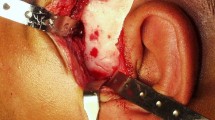Abstract
Introduction
Mandibular hypomobility may arise due to a wide variety of intraarticular as well as extraarticular disorders in the temporomandibular joint region. Temporomandibular joint ankylosis causes a variable restriction in jaw mobility. This study presents a broad overview of the management of temporomandibular joint ankylosis at the Department of Oral and Maxillofacial Surgery, GGSM Subharti Dental College, Meerut, Uttar Pradesh, India.
Materials and methods
Between May 2002 and September 2005, a total of 44 patients underwent surgical release of temporomandibular joint ankylosis. This study is a retrospective analysis of the patient population characteristics and the surgical procedures employed.
Results and discussion
The patients have completed a follow-up of 24 to 64 months (median, 38.5 months). Of the 44 patients, 12 had bilateral involvement. Trauma in childhood was, expectedly, the most frequent etiologic factor. Gap arthroplasty was the most frequently employed technique, followed by the use of autologous tissue interposition. The temporalis muscle-fascia and the temporalis fascia alone, as well as the auricular cartilage, were employed most frequently. Complete alloplastic condylar replacement was performed in one patient, who, unfortunately, returned with pain, clicking, and deviation of the jaw, necessitating removal within 1 month. Total joint replacement was abandoned after this case. We outline our protocol for the management of this disabling condition.





Similar content being viewed by others
References
Rowe NL (1982) Ankylosis of the temporomandibular joint. J R Coll Surg Edinb 27:67–79
Al-Kayat AP, Bramley P (1979) A modified preauricular approach to the temporomandibular joint and malar arch. Br J Oral Surg 17:91–103
Blair VP (1913) Operative treatment of ankylosis of the mandible. South Surg Gynaecol26436–451(Cited from Kreutziger KL (1984) Surgery of the temporomandibular joint I. Surgical anatomy and surgical incisions. Oral Surg 58:637–646)
Alexander RW (1975) Postauricular approach for surgery of the temporomandibular articulation. J Oral Surg 33:346–350
Sarma UC, Dave PK (1991)Temporomandibular Joint ankylosis: an Indian experience. Oral Surg Oral Med Oral Pathol 72:660–664
Roychoudhary A, Prakash H, Trikha A (1999) Functional restoration by gap arthroplasty in temporomandibular joint ankylosis: a report of 50 cases. Oral Surg Oral Med Oral Pathol Oral Radiol Endo 87:166–169
Kaban LB, Perrot DH, Fisher K (1990) A protocol for the management of temporomandibular joint ankylosis. J Oral Maxillofac Surg 48:1145–1191
Chidzonga MM (1999) Temporomandibular joint ankylosis: review of 32 cases. Br J Oral Maxillofac Surg 37:123–126
Adekeye EO (1983) Ankylosis of the mandible. J Oral Maxillofac Surg 41:442–449
Kazanjian VH (1938) Ankylosis of the temporomandibular joint. Surg Gynaecol Obstet 67:333–348
Tideman H, Doddridge M (1987) Temporomandibular joint ankylosis. Aust Dent J 32(3):171–177
Topazian RG (1966) Comparison of gap and interposition arthroplasty in the treatment of TMJ ankylosis. J Oral Maxillofac Surg 24:405
Salins PC (2000) New perspectives in the management of craniomandibular ankylosis. Int J Oral Maxillofac Surg 29:337–340
Long X, Li X, Cheng Y, Yang X, Qin L, QiaoY , Deng M (2005) Preservation of disc for the treatment of traumatic temporomandibular joint ankylosis. J Oral Maxillofac Surg 63:897–902
Gunaseelan R (1997) Condylar reconstruction in extensive ankylosis of temporomandibular joint in adults using the resected segment as an autograft: a new technique. Int J Oral Maxillofac Surg 35:157–160
MacIntosh RB (1994) The case for autogenous reconstruction of the adult temporomandibular joint. In: Worthington P, Evans JR Controversies in oral and maxillofacial surgery. WB Saunders, Philadelphia, pp 356–380
Figueroa AA, Gans BJ, Pruzansky S (1984) Long term follow up of a mandibular costochondral graft. Oral Surg 58:257–268
Guyuron G, Lasa CI Jr (1992) Unpredictable growth pattern of a costochondral graft. Plast Reconstr Surg 90:880–886
Link J, Hoffman DC, Laskin DM (1993) Hyperplasia of a costochondral graft in an adultJ Oral Maxillofac Surg 51:1392–1394
Saeed NR, Kent JN (2003) A retrospective study of the costochondral graft in TMJ ReconstructionInt J Oral Maxillofac Surg 32:606–609
Author information
Authors and Affiliations
Corresponding author
Rights and permissions
About this article
Cite this article
Jain, G., Kumar, S., Rana, A.S. et al. Temporomandibular joint ankylosis: a review of 44 cases. Oral Maxillofac Surg 12, 61–66 (2008). https://doi.org/10.1007/s10006-008-0103-y
Published:
Issue Date:
DOI: https://doi.org/10.1007/s10006-008-0103-y




